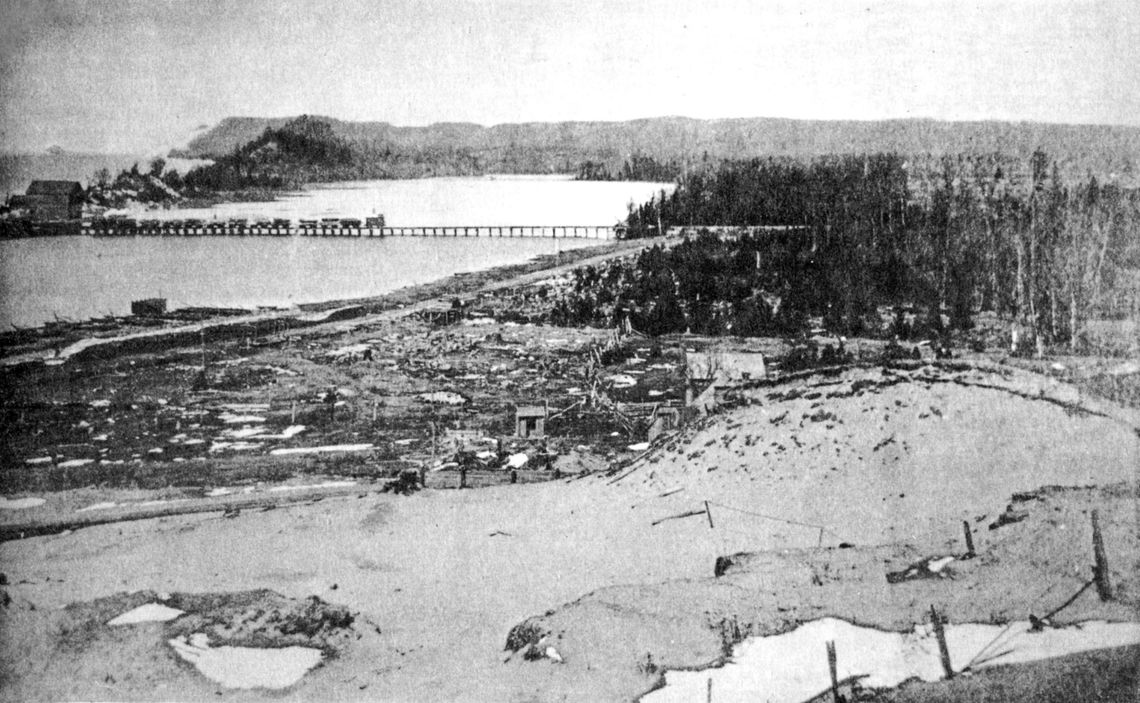An excerpt from “Some Other Day: Remembering Empire” by the Empire Area Heritage Group
The T. Wilce Company of Chicago, Illinois was founded by Thomas Wilce St., in the late 1880s, and their business was the lumber industry. Mosts of the lumber was cut by sawmills located outside the city, and then shipped to the city by brain or boat. The lumber was then dried, and the finished product was made by the company’s special planing mills.
About 1888, three sons of Thomas, Sr., took over the business. They were George, Thomas, Jr. and Harvey. A short time later, a strip of land on Lake Michigan in the village of Empire, was purchased. A large circular sawmill was now built at the south end of South Bay Lake, and the Wilce Company was ready to operate there.
At this time, George was general manager in the Chicago area with Thomas Jr., as his assistant. Harvey was no chosen to manage in the Empire area.
Virgin timber was now bought from many old settlers here, and many acres of land with this kind of timber from the U.S. Government. Logs were then cut and hauled to the mill by teams of horses and sleighs on snow. Large two-wheeled vehicles hailed some logs in summer. They were then cut into lumber, slabs and edgings in the mill.
TWO DOCKS BUILT
As most of the lumber had to be shipped to Chicago, two docks were built out in Lake Michigan. This let boats come in to load up, and haul lumber, etc. to the city. The south dock used mainly for lumber as it was near the mill. Lumber piled on it was loaded on steamships and hauled to Chicago.
Tramways, as we called them, were built in this section. These consisted of two upright lumber beams, 8 ft to 12 ft. high, with a 12 ft. beam placed on top. Twoby- eight-inch joists were nail on top of the beam, and hardwood lumber was nailed on the joists. These beams were about 16 feet apart. They were braced good, and this made a 12 ft runway. This runway sloped a little downhill and from the mill to the lumber yards, and on to the dock. High lumber piles were placed on each side of the runway, and one-inch strips were placed across the ends and center of each tier of lumber. This let air circulate on both sides of the timer, so it would dry fast.
The lumber was now placed on a wide two-wheeled cart, and push down to the dock. Here a very large pile was placed on the south side, about 6 ft. high and 125 feet long. When the steamboat came in to load, the lumber was usually ready for them. The boats always backed in to load, and dredging the same on the bottom by the ship’s propeller was necessary to let the ship back in at times.
The north dock was built about 80 rods north of the south dock, and was used mainly to load slabs and edging from the mill on the sailboats. These were shipped to Chicago and Milwaukee and used for firewood. Some hops and hemlock bark were also put on these boats and shipped to Milwaukee.
The bark was sued for tanning leather, and the hops for flavoring beer. A large warehouse was also built to the north dock, as the company erected a large general store here early, and most merchandise was shi00ed in by boat. This made a good place for storage.
Shortly after the mill was built, or about 1890-, work was started on the railroad. A rightof- way was obtained from each person who owned the property where the railroad was to be located.
Next, locomotive was purchased from a Manistee company, and pulled to Empire on snow by a team of horses and a large sleigh. Rails and flat cars were bought and shipped here by boat, and a railroad bridge was built across South Bar Lake east of the north dock. A “Y” or yard was laid out at the west end of the bridge, and a railroad bed graded south from the “Y” was used to turn the engine near the east side of the mill. The “Y” was used to turn the engine or cars around to face the opposite direction.
The railroad also extended out to the end of the north dock.
The rails were laid first in this section, and across the railroad bridge, and the engine and flat vars put on the rails. Where the railroad ended next to the mill, long straight timbers were placed to run from the railroad to South Bar Lake.








